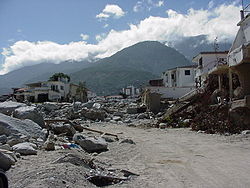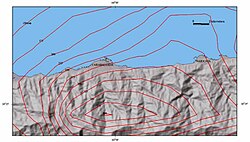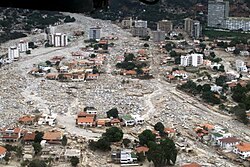Vargas tragedy
Vargas tragedy is one of the worst disaster that struck the Venezuelan country's Vargas state on 15 December 1999. It was a result of heavy downpour of rain, flash floods and mudslides that followed on 14-16 December 1999 which killed 10,000*30,000 peoples.This disaster led to an complete collapse of the infrastructure of the state of Vargas.
Many towns were swept away to the ocean due to the floods.Whole towns like Cerro Grande and Carmen de Uria completely disappeared. As much as 10% of the population of Vargas perished during this event.The coastal area of Vargas has long been subject to mudslides and flooding: geologically similar catastrophes occurred with regularity. The most recent major flood was in 1951, however that event did not cause as much damage.[1]
In a 52-hour span during 14, 15 and 16 December 1999, 91.1 centimeters (35.9 in) of rain (approximately one year's total rainfall for the region) was measured on the north-central coast of Venezuela at Simón Bolívar International Airport in Maiquetia, Venezuela. These heavy rains included 7.2 centimeters (2.8 in) of accumulation in just one hour, between 6 and 7 AM on the 16th; precipitation on both the 15th and 16th exceeded the 1,000-year probability rainfall event. Even so, the coast received much less rain than some regions upstream.
The disaster caused estimated damages of USD $1.79 to $3.5 billion.[1] The death toll was considered to be between 10,000[2] and 30,000[1]—the exact number of casualties is difficult to determine as there was no reliable census data, especially about shanty towns and small communities that were completely wiped out; moreover, only some 1,000 bodies were recovered, with the rest swept to sea by the mud or buried in the landslides.[1] More than 8,000 homes and 700 apartment buildings were destroyed in Vargas displacing up to 75,000 people.[1]
Vargas Tragedy Media
Isohyet (contour of equal precipitation) map of the 14–16 December 1999 storm draped over a shaded relief map of north-central Venezuela
Oversteepened hillslopes failed during the rainstorm, sending landslides of soil into the channels (such as the braided river at bottom) and supplying sediment to flash floods and debris flows. The transmission tower on the right side of the image is 30 meters (98 ft) tall.
Damage from the debris flow on the Caraballeda fan. The main channel (at left) avulsed to a new course that led it through the houses to the right. These avulsion deposits are up to 6 meters (20 ft) thick and total about 1.8 million cubic meters of boulders and other material.
References
- ↑ 1.0 1.1 1.2 1.3 1.4 Wieczorek GF, Larsen MC, Eaton LS, Morgan BA, Blair JL (2 December 2002). "Debris-flow and flooding hazards associated with the December 1999 storm in coastal Venezuela and strategies for mitigation". U.S. Geological Survey. Retrieved 31 March 2010.
- ↑ Rivero, Yensi (2007). Venezuela's Vargas Disaster Hard to Forget. Tierramérica. http://www.tierramerica.net/2004/0105/iacentos.shtml. Retrieved 31 March 2010.







